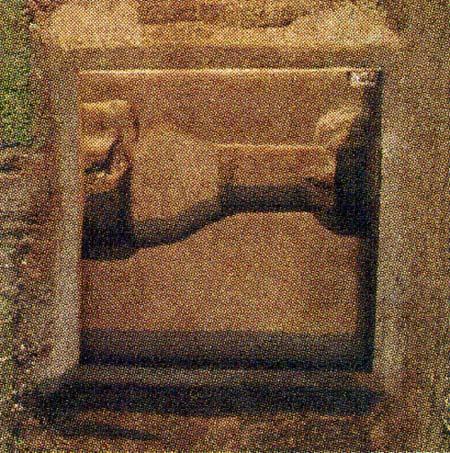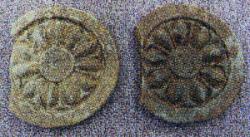2011 Excavation of the Zhaopengcheng Northern Dynasties Monastery at the Yecheng City-site in Linzhang, Hebei Province
Chinese Institute of Archaeology
Source - http://www.kaogu.cn/en/detail.asp?ProductID=3405
The Yecheng City-site, located at 20 km southwest of Linzhang downtown in Hebei Province, is the ancient capital city of Cao-Wei, Later Zhao, Ran Wei, Eastern Wei and Northern Qi six dynasties. The site is composed of the North and South two cities. The site of Zhaopengcheng Northern Dynasties Monastery lies in 200 m southwest of the Zhaopengcheng village in Xiwen Township, Linzhang County, 1 km south of the Zhuming Gate to the South City. Since 2002, Yecheng Archaeological Team of the IA, CASS has explored and excavated the foundation of the Buddhist pagoda, the encircling trench, the enclosing corridor of the southwest yard and the passage at the east of the trench. Through excavation the size and layout of the monastery are made clear. The monastery, sitting towards south, has a square layout with an encircled trench measuring 5-6 m wide and 3 m deep, 452 m from south to north and 434 m from east to west. The foundation of the pagoda, found in south central of the monastery, is square in shape. The upper part above the ground measures ca. 30 m wide. Two large-sized yards are arranged respectively in the northeast and southwest corner. They both have a square layout surrounded with buildings with each side measuring 110 m long. In the north central of the yard there is a large-sized rammed earth foundation.

In order to further explore the layout of the southeast yard, especially the structure and building technique of the large-sized building inside the yard, with the permission of State Bureau of Cultural Relics, from October 2011 to January 2012, archaeologists have excavated foundations of the large-sized hall, the surrounding corridor, the connecting corridor, and the passage at the south trench. 18 test pits and 1 long test ditch, totally 2,000 square meter, have been uncovered.
The foundation of the large-sized hall is located at the middle north of the southeast yard. Towards south, it has a rectangular layout measuring 36.6 m long from east to west and 23.4 m wide from north to south. The foundation is seriously destroyed, remaining only a platform above the ground and the underground foundation. The upper foundation, in poor preservation, is constructed with a layer of rammed earth. In the central and the south there remain rammed earth about10 cm high, while in the west and the north nothing left. No column base stone has been found on the foundation, however, some probable column holes in round and square shape could be seen at the center and near the east, west and north edge. Totally 36 holes are arranged in 7 lines with each line containing 6. Most of them are round in shape, except 7 in the east part are in rectangular or irregular shape. The holes measure 50-80 cm in diameter and each neighboring two space ca. 2.5 m apart. Inside many holes, white wall plaster pieces are found and no wood remains. The lower part of the foundation is composed of a rectangular rammed earth belt surrounding six parallel elongated rammed earth belts, each measuring 3.1-3.5 m wide.

The hall foundation is connected with the surrounding corridor with two sections of corridors on the east and west side. Parts of the east section and the whole west section have been uncovered, and a complete rammed earth platform is found. 11 post-holes are found symmetrically along the west section on the two sides, each measuring 50-60 cm in diameter and 4.5-5 m apart from each other, extending 6 m long from north to south.
The west section of the surrounding corridor is in good preservation. It consists of the upper platform and the underground foundation. The underground foundation is built with 4 elongated rammed earth belts. The south section extends 12.94 m long from south to north. The underground foundation is built with 4 elongated rammed earth belts measuring 84 cm thick.
At the middle of the south trench there is a passage. It has a shallow ditch in the central to connect east and west side of the trench. The east section is well preserved measuring 1.2 m wide and 0.6 m deep. The west section is seriously destroyed. It has a slanting bottom which extends to the bottom of the west trench. The east and west trench are preserved well, with the upper opening damaged and in nearly semicircular shape. The bottom is in rectangular shape. The east trench, 1.4 m deep, with the opening 6.5 m wide and the bottom 3.2 m wide, contains silt and tile pieces, most of which are of thick flat type and regular in arrangement. The west trench is 1.55 m deep, with the opening 5.1 m wide and the bottom 2.5 m wide. On the bottom there also remain piles of tile pieces.
The outcome from the site is mainly green bricks, flat and curved tiles and tile ends. There are also some pottery and porcelain pieces. The tiles are well shaped and heavy. Many of them bear inscriptions. All tile ends are molded with locus patterns.
Combined with previous findings, the layout of the Zhaopengcheng Monastery is made clear to be a multi-yards structure with a pagoda as the center. The large-sized buildings in the southeast yard uncovered in 2011 are built with unique technique. It has 8 elongated underground rammed earthen belts supporting a layer of rammed earthen platform. From the distribution of rammed earthen belts, the buildings’ columns and multi-rooms structure could be perceived. The large-sized hall in the north of the southeast yard is proved to be a main Buddhist hall, which provides important materials for studying the layout, constructing techniques of the large-sized Buddhist halls from Northern Dynasties. The same type of layout is never seen before among Northern Dynasties remains, while similar with the houses beside the main hall in Qinglong Monastery and Ximing Monastery from Tang Dynasty, indicating that monasteries from Eastern Wei and Northern Qi dynasties were in a transitional stage in 6th century.
The Zhaopengcheng Buddhist Monastery is one of the hitherto found highest class Buddhist monasteries. The yield of 2011 excavation enriches our knowledge to the whole monastery and provides important archaeological materials for studying the evolution of Buddhist monastery layout from the earlier yard centered the pagoda to the later yard centered the main Buddhist hall. (Translator: Tong Tao)